#made them a gynandromorph
Text
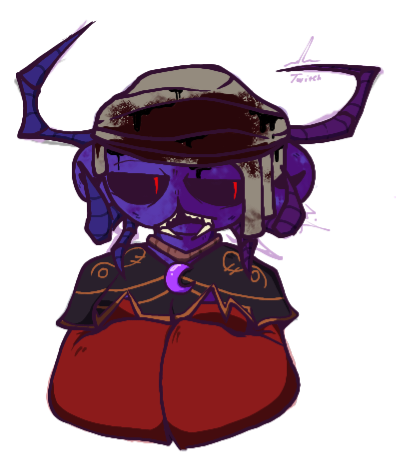
Shamura warm up doodle
#cult of the lamb#cotl#digital art#art#cotl art#cotl relics of the old faith#cotl sins of the flesh#cotl shamura#cult of the lamb shamura#follower shamura#shamura#made them a gynandromorph#because i can#thought it would be fun#and it makes them look awsome#gender is bullshit#they get both#and also none#character art
75 notes
·
View notes
Text
I've looked at some Strange Magic screencaps today and I've been thinking about the differences between male and female fairies. You know, like a normal person does in their spare time. The general difference between the two is visually obvious. Female presenting fairies have iridescent looking wings with little to no patterns (other than the black and white pattern lining Dawn's wings like those of a monarch butterfly). Male presenting fairies have more neutral coloured wings with markings and lines and spots on them.
Because of how unpopular and generally small the fanbase is I couldn't find anything concrete as to why that is the case. I've seen a single concept art depicting the male fairies as moths although the wings do not match the final design in the movie. The Fandom wiki dubs them all to be butterflies though as a whole I do not trust what Fandom says. You could also argue that they're different because it's Disney and Disney loves its stereotypical gender differences. And of course searching through interviews showed me nothing as of yet.
However, even whilst having nothing to support this, I have an idea as to why they look so different.
Something I have never realised, and now refuse to let slide, is that butterflies show sexual dimorphism. Their wings are different between male and female members of the species which could explain the different wings in the film (other than it being a cartoon made for kids and the fact it's not that deep). Most often these differences are small, like a particular small pattern change or slight variation in the hue of the wing colour. However, certain species show very strong dimorphism:
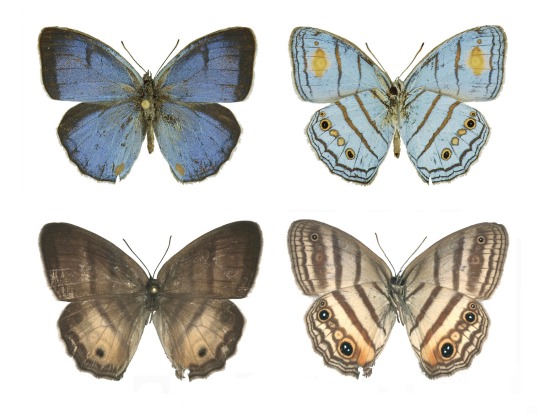
^ Males of the species are blue, females are brown (Images taken from this article on FloridaMuseum)
Which is sort of what is going on in the Strange Magic movie, only reversed with the females having the more vibrant colours:

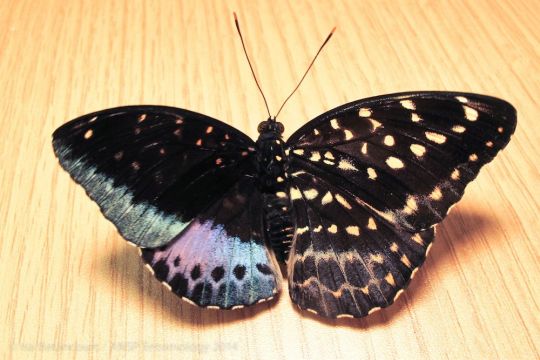
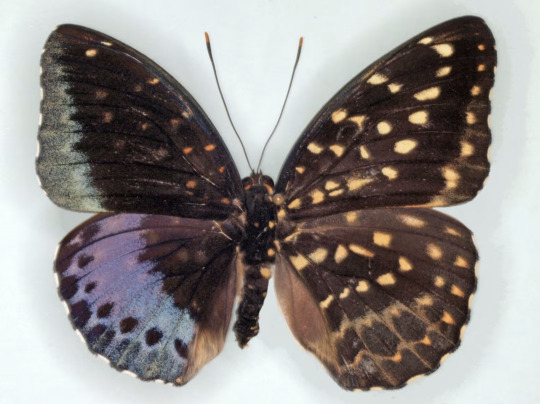
^ I think the differences are best seen in butterflies that show both female and male wing patterns (Images taken from this article on Washington Daily). And if anyone is interested, the condition is called Gynandromorphism (wikipedia page)
In this case, it's possible that all fairies have butterfly wings. And yeah, I would have gone into way more detail but I kind of got tired by the end if you can't tell by the way I'm cutting it short. I think the way they fly also resembles butterflies more than moths, buuuut they also fold their wings flat on their backs with is more accurate to moths than butterflies. Either way, sexual dimorphism is my go to theory now.
#strange magic#I don't know what else to tag#It's literally only strange magic related#toonce offtopic#and yes essay writing has made me reference everything..#also#I'm sorry Strange Magic is younger than the fnaf games?#This movie came out in 2015???#also also I might add to this post later
11 notes
·
View notes
Text
'The dawn rays of the rising suns highlight the imperfections of nature's workings as a pair of female pterowrists, emerging at first light, prowl among the burrows of a colony of marmoths in the hope of picking off a straggler when they surface to forage. Yet something peculiar is immediately noticeable with one of them, her stunted size compared to her partner and her asymmetrical, elongated left wing marking her as something incredibly rare: she is a gynandromorph, a rare aberration produced by a chromosomal anomaly that results in an organism with a chimeric patchwork of male and female traits. This trait is also found in other species, but nowhere is it as visually dramatic as in a species with such an extreme sexual dimorphism as the pterowrist: producing such bizarre morphologies that greatly affect the ontogeny of the creature with its abnormal hormonal signals. This individual, however, seems quite prosperous in spite of it all: managing to survive to adulthood and adjust to her lopsided anatomy. Even so, she will never reproduce, or pass on her unusual trait: her hormonal signals have made her behavior in that she is attracted instead to the scent of another female, and even otherwise cannot produce viable egg cells with her impaired chromosomes that interfere with meiosis. Though an individual success, managing to reach such an age despite a physical anomaly, she ultimately is but a rare sporadic fluke-- produced mistakenly with extreme rarity and a dead end for the genes that made her so.'
--------
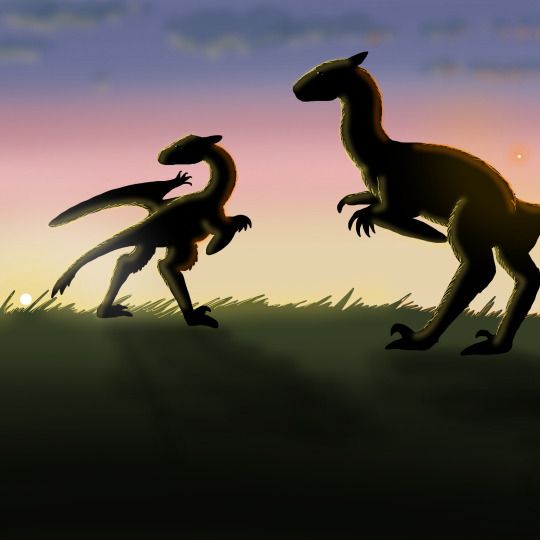
60 notes
·
View notes
Note
i spent entirely too long today going through your 'dime made this' tag chronologically, and seeing your art skills and worldbuilding evolve over time, especially with the saratoans, was beautiful. also you havent draw the sentient bees in a while! is there any particular reason for that? are they in a separate world from the hydras and dryads and other magic stuff?
Thank you! It delights me to know people go back that far, it's one of my favorite things about having so much of my work archived here
I'll be honest, what happened was that I had a bit of a traumatic time in 2016, when I became briefly homeless, on top of other problems I won't enumerate just for the sake of brevity but it was like the straw that broke the camel's back. It was like all my interests died at the time. Burnout, I guess.
Honey bees were my major number one interest at the time, to an obsessive degree (ask anyone who was following me at the time, the depth of the sort of research I did was truly maniacal), so I guess as interests go, it had the furthest to fall and has been the hardest to recover.
Honestly losing such a major interest was in and of itself a bit traumatic. Maybe that's part of why I didn't even force myself to draw them like I continued doing with other characters even when I didn't enjoy drawing them - not finding it fun made me want to cry (and I did a few times, honestly).
I don't think I'll never draw them again, I still care about them and still love arthropods, but I have to work through some stuff and I'm trying not to put pressure on myself - I did that before and it made the burnout worse.
I'm trying to just embrace my artistic dry spells right now and come back to things when I want to - focusing on other hobbies in the meantime, instead of turning every period of art block into a full blown existential panic attack.
They are intended to be in the same setting as the others, they were a little less integrated in terms of depicting them with other species since I always envisioned them as having a harder time interacting with other sapients in the setting, for a number of reasons (perception of time, language barrier, mutual lack of recognition of each other as people), and my plot ideas were mostly internal hive politics and inter-hive politics with other sapients being mere background noise.
Since then I've been working a little on figuring out some of the overall magical climate and how dryads affect it and which creatures can exist in which environments as a result (basically every forest on the planet can have either dryads or magiphages but not both)
Because of this when I come back to them I'll probably depict them with dryads more, since dryads = low magic environment, and I always wanted them to be shown against more natural less wacky looking backdrops.
I always intended to depict that gynandromorph one as attending college though out of pure humor. World's tiniest student in your ASL class.
88 notes
·
View notes
Text
Binary trans experiences have been well integrated in Centauri society from ancient history. Once upon a time, these also included nonbinary, genderfluid and gender nonconforming individuals, as well as intersex Centauri, most commonly bilateral gynandromorphs.
This former diversity was annihilated almost entirely by Republic led propaganda campaigns, painting anything outside the gender or sex binary as a medical or cultural aberration.
Visibly intersex children who could not be treated with hormones or by other means were often terminated, and less visible intersexuality kept well hidden. Individuals who expressed gender divergent identities likewise medicalized and pushed toward transition to a binary gender.
This oppression of gender minorities and careful control of even binary trans people served the purpose of enforcing the Republic's machine, largely built on weaponizing our traditional gender roles.
Famous anarchist revolutionary Fressea Ceti Koto (no known relationship to Emperor Vir Cotto), who was executed for treason after being found responsible for a campaign of pipe bombings against high value political targets, made divergent gender expression central to his ideology.
Born sickly and epileptic, Fressea also had a mutation that left their crest an extremely light color for his entire life, something that carried a stigma of emasculinzation due to its association with women's hair. He embraced this, adopting human they/them pronouns in addition to his male Centauri ones, dressing in drag and often filling the role of a woman in their relationship with his fellow anarchist and lover, the equally genderfluid trans woman Koya Koto. Koya was known for keeping her crest even after transition and extolling it as a symbol of her femininity.
#alienkin#alterhuman#history lessons#the two genders paintbrush and ponytail#the great misc tag empire the lion of the galaxy
3 notes
·
View notes
Text
Basil
I realized I never posted about Basil even though he's like one of the main four I usually draw besides Wally-
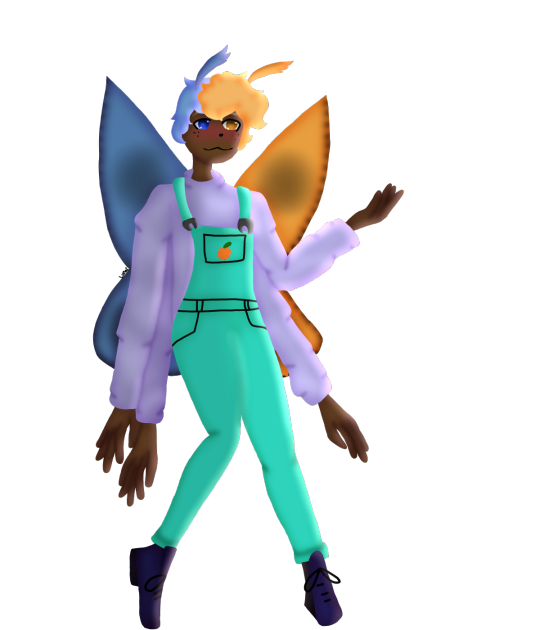

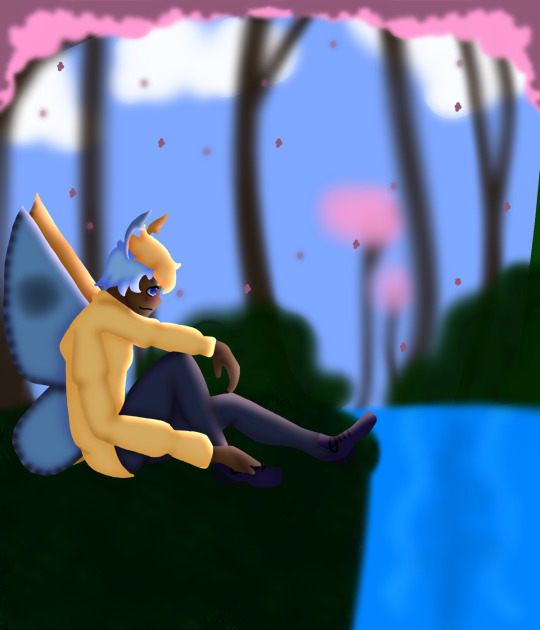




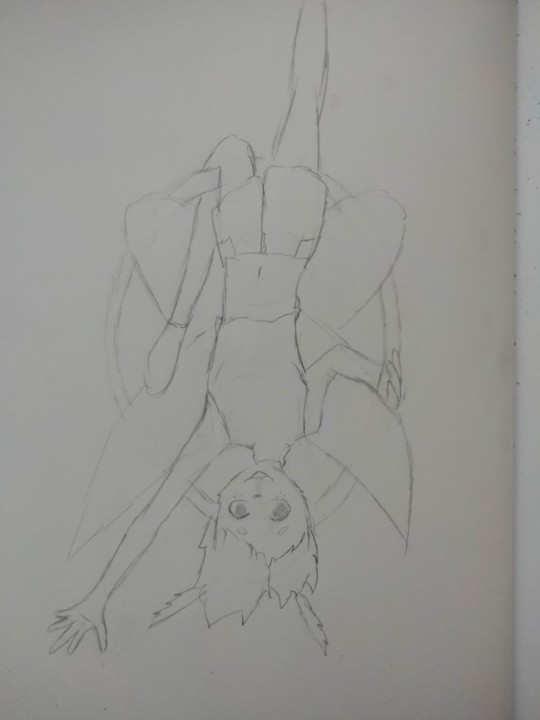

I'll be truthful, I drew so much of him. Also the second doodle on paper is from one of my besties (Beee!) And the picture where he's cuddling with someone is her oc Fang, aka his husband usually
But in welcome Home, I'll admit I made home humanoid. While it isn't new, we just have him get married with Basil but it's nice at least
Some facts about Basil:
He gets very cold in the winter so he loves cuddles during then since he doesn't have fuzz unlike Fang
Basil is a early bird and often is only awake during the days. Though if he's with someone who is awake only during the night (say fang) he'll drink energy drinks or force himself to stay awake until you force him to sleep
Basil is very lengthy and often is not very strong (as intended)
He actually likes listening to soft rock or music without lyrics. It really depends on his mood. He'll even listen to hyperpop once in a great while
He is a photographer as part time job, but he loves it! Though he also loves to garden and sewing. Especially when he has to fix clothes. Once in a while, he'll find himself exploring the woods
He is 5'8 so he's pretty tall
He'll often wear overalls and a sweater during the winter. On his main overalls is a orange! Though he'll wear shirts with other fruits on them or tank tops with shorts.
He has heterochromia (orange and blue eyes!)
He is based off of a gynandromorph! More specifically this one:

He gets very eepy during the winter too! To help preserve energy
He is 25!
He would unironically listen to Caramelldansen if you ask him to
His favorite no lyric type of music is video game music! More specifically the soundtracks for animal crossing and Minecraft! Along with Stardew Valley and Slime rancher OSTs
He fell from a height when he tried to fly with his wings so he doesn't fly often
Man is also very dramatic. He can and will make a scene if he doesn't get his way
He also knows he can get away with a lot so when he's in trouble, he'll often put up a fake sorry act to get away with it!
That is all the information for now! I don't want to spoil anymore!
2 notes
·
View notes
Note
GIVE ME FOXGLOVE CONTENT pls any general stuff like fave foods to eat fun stuff she likes to do
TEEHEE my worlds biggest Foxglove fan, i too am not immune to my own giant woman...
Foxglove is still evolving as a character BUT here are some tidbits for you:
Her favorite foods are probably spicy enough to kill a lesser moth
Despite her love of spice, she also has an intense sweet tooth, and hoards hard candies in a small cubby she carved into the underside of her bedframe
This hiding place has likely not stopped her siblings (Reed, Hyacinth) from stealing them
Foxglove can digest meat. And has, in the past. Don't worry about it.
She takes up blacksmithing as her main profession under her father, Atlas.
While she thinks weaponsmithing is cool as fuck, Foxglove's main skill is actually in practical smithing, like forging harnesses, tack, stag-shoes, etc.
Foxglove doesn't perform in the troupe, but serves as more of a general handy-moth, especially when it comes to structural repairs and metalwork.
Foxglove's weapon(s) of choice are two leather caestuses that she made herself, often with black iron plates over top of them if she's in a real fight. Basically, moth brass knuckles.
When forced to choose a handed weapon, Foxglove favors the mace and hammer.
Foxglove is a chimera bilateral gynandromorph, and is the result of two fertilized eggs fusing together. She is technically Nightshade, Atlas, and my oc Valka's all at once, as Atlas and Valka both had knocked up Nightshade around the same time.
Foxglove cannot fly, as her wing-to-body ratio is way too low. Since she doesn't have to worry about being able to carry herself, she's bulked up a ton through strength training, and has a lot more brawn than most moths.
Atlas is the only person she knows of that can still physically best her in terms of strength, but it's close.
Foxglove is a daddy's girl through and through. Reed and Hyacinth may be more Nightshade's, but Foxglove is Atlas' baby.
Foxglove and Valka have a ... strained relationship at best. Valka is barely involved in her life, through little fault of her own. She genuinely didn't know that Foxglove existed, and when she did, she tried to reconnect and help where she could. Foxglove still isn't sure if she wants Valka to be a more prominent figure in her life or not.
Foxglove's girlfriend is Lady Lambfeathers, the daughter of the capitol city's Harbormaster and Captain of the Guard. I'm sure nothing will go wrong there.
Foxglove and Lambfeathers are T4T
Foxglove's favorite drink is rye whiskey
Foxglove can play the banjo (daddy taught her)
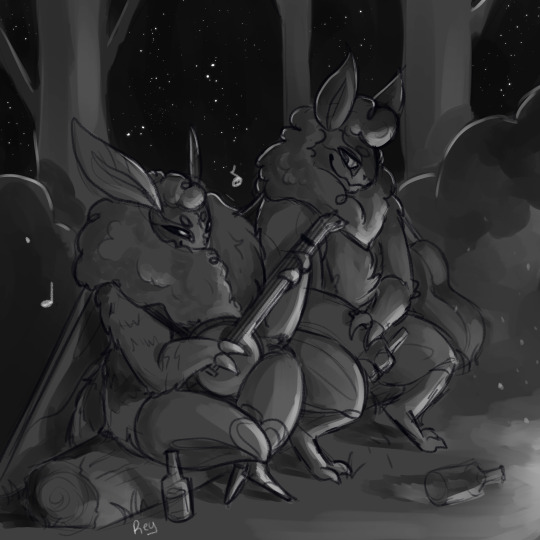
#oc: foxglove#asks#my ocs#my art#thank u :3#she's my newest baby but i love her so so much#just bad at open ended questions asfgh#me all day: oc thoughts#me when asked to give oc thoughts: UHHH#mallowdraws
6 notes
·
View notes
Text
i believe it’s pretty common knowledge by now that all 5 titled mantis characters in hollow knight are trans (comparing their character designs/physiology to real life mantises, since you can tell a mantis’ sex by the shape of its abdomen)!
because so many bugs have such extreme sexual dimorphism irl, this can bring a lot of cool Gender implications when observing hollow knight characters (there’s a non-zero percent chance that someday you may see a post from me along the lines of The Radiance Hollowknight Is A Gynandromorph, In This Essay I Will).
but for now let’s talk about....................................................... pill bugs!!!
in real life, you can tell an isopod’s sex by looking at the shape of its stomach plates!
isopods’ stomach plating is in two rows of horizontal slats that meet in the middle of their bodies. on a male isopod, the plates are slanted in a V shape, like this:
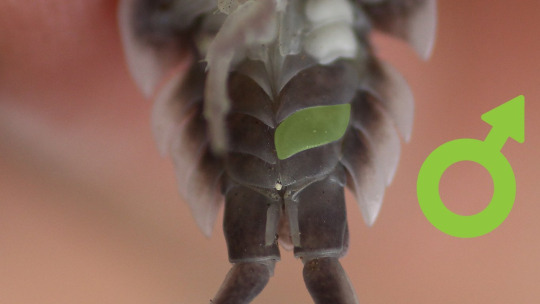
[img desc: close-up photograph of a male isopod’s butt, showing his belly plates meeting in the middle in a dramatic, slanted V shape. one segment is highlighted light green to point this out, and a mars/male symbol is stamped helpfully nearby]
while on a female isopod, the plates are straight across, like this:
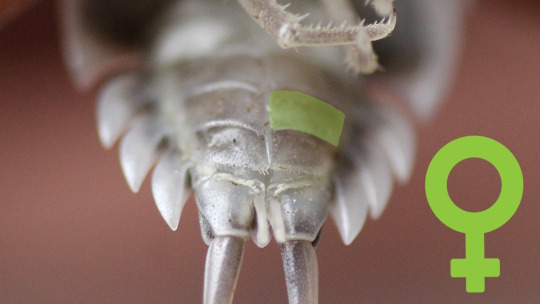
[img desc: close-up photograph of a female isopod’s butt, showing her belly plates meeting in the middle. there’s a little bit of a curve to them but they are still horizontal, unlike the extreme diagonal shape of a male’s plating. one segment of her plates is highlighted light green to point this out, and a venus/female symbol is stamped next to her helpfully]
and those straight-across belly plates are what hollow knight’s pill bugs all look like.
now, hollow knight’s pill bugs are WAY more heavily stylized than a lot of the other bug species in-game, and it’s hard to tell whether team cherry made this design choice deliberately. so i wouldn’t say that this is as 100% conclusive as it is with the mantis lords/traitor lord/traitors’ child. ESPECIALLY in the case of generic enemies and myla, who doesn’t have a unique character design!
however... there IS one pill bug in the game who DOES have a unique character design, and if we take a look at the shape of his underside plating...
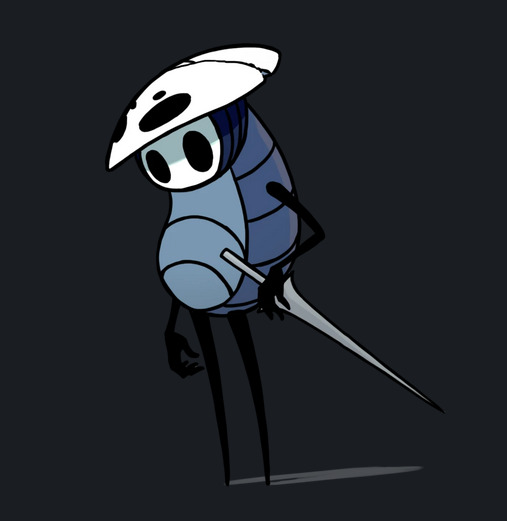
[img desc: quirrel’s promotional art, screencapped from the wiki because screw messing with webp files. his belly plates are straight across... except for where they meet his back plates. the lines actually sink downwards there to emphasize that quirrel has a chubbier belly than generic pill bug characters!]
that sure doesn’t look like a V shape to me!
(quirrel voice clip noise) HMM!
#hollow knight#hollow knight meta#quirrel hollow knight#hk quirrel#THE RUMOR COME OUT: DOES QUIRREL IS TRANS (the answer: quite possibly yes he do!!!)
474 notes
·
View notes
Note
i'm sorry that this isn't directed at a character but your eve keane posts have made tumblr suggest me 'bugblr' posts which have been insanely cute! it makes me have a newfound appreciation for insects, so thank you for that
!!!
This is absolutely lovely 💛 I have a deep love for insects (as everyone in my real life can attest) hence my username! So it's great for me that I get to spread the love of them to someone else! They're really incredible! Today I read about a pet stick insect over here that's been confirmed to be a gynandromorph - meaning that they're half male and half female! And they're called Charlie!!!! How cool is that?
14 notes
·
View notes
Note
Sex is defined by gamete production. Don't pretend you're an ally to intersex people. We're not fungi, we're mammals. It's fucked up you think our medical conditions mean we're less male or female than perisex people. That's a prejudice you need to unpack.
All I said is that sex is naturally a bimodal distribution, intersex animals exist and are not inherently non-binary (since that feels anthropomorphic), and that prejudice against intersex people is a human problem. How is pointing out intersex animals an issue? Enjoying the diversity of sex/mating types in mycology is not harming intersex people. You aren't a fungus, agreed. Some intersex people align to one binary sex, some are in the middle. Some consider it a medical condition, others just a way of being. For animals, it's always just a way of being. They don't need treatment. If an intersex human wants medical treatment to better align with one binary sex, good for them. But that's not the only way to be intersex, and other intersex organisms don't do that.
Gender is an entirely separate issue, and intersex people are whatever gender they claim they are. Many do not see themselves as binary male and female, and many do - both are equally valid takes, as are third genders/cultural genders. I would wager most CAIS folks don't see themselves as anything other than female, and rightly so (Maybe you don't, since they don't produce eggs, but if you think CAIS people are inherently men that's a big yikes).
I hardly think celebrating an intersex lion and other intersex animals I've had the chance to work with (masculized galliformes are more common than you think) is what's harming intersex people when it's still the norm to operate on newborns to "correct" their genitals or having a period is made out to be what makes someone a woman. Or even only thinking of intersex only as a medical condition. Granted, I don't think being compared to other lifeforms is in any way an insult. There's no real hierarchy to life. I will be consumed by fungus when I die and the bacteria in my gut influence my brain. What gametes one produces is incidental at best, but I think people lauding an intersex lion as a butch lesbian icon or inherently non-binary are ignoring that she's the way she is because of her hormones, making her intersex. It's natural variation, not an affliction.
Biology is wonderful because it is messy and for every rule you try to make, there is something to break it. We can't even define species without there being rulebreakers (looking at you, Canis and Larus). Of course sex also has rulebreakers. Not following the rules is not inherently wrong, it's just a way of being. Breaking the rules a little is how evolution happens. Some mutations are good, some mutations are bad. Many are neutral.
But gotta say, this smells super TERFy, of the sort where being intersex is only a tragic medical condition and not just a neutral way of being. And a cognitive dissonance of not being allowed to identify as being in-between, or anything beyond what you're assigned at birth. Enjoying an intersex lion just existing and being intersex is not an attack on intersex people any more than cooing over gay penguins is homophobia. She doesn't have a medical condition. We don't try to alter intersex animals in vet med (other than making sure they can urinate), because that's invasive and the animals do not care. They fit in with their conspecifics anyways.
Intersex people are part of the tapestry of human diversity, and are worthy of love just like the masculized lioness or a gynandromorph butterfly.

(Bilateral gynandromorph rose-breasted grosbeak - a normal, healthy bird, just a chimera.)
If you don't like my takes on sex diversity being a neutral, normal thing, don't stick around for my takes neurodiversity, I see it much the same way. We're all cousins on a great big wet rock spinning through space and we're more alike than we are different, and what differences we have are worthy of celebration.
#I'm not the only one that finds this ask weird right?#Intersex-as-only-ever-medical definitely smells of exclusion and TERFery#God forbid the intersex lion doesn't have to deal with exorsexism because that's a human hangup#As conspecifics we are all more alike than we are different - sex and gender are not that important in the grand scheme of things#As always I struggle to understand y'all with innate gender/sex identity#Is this unpacked enough?
14 notes
·
View notes
Text
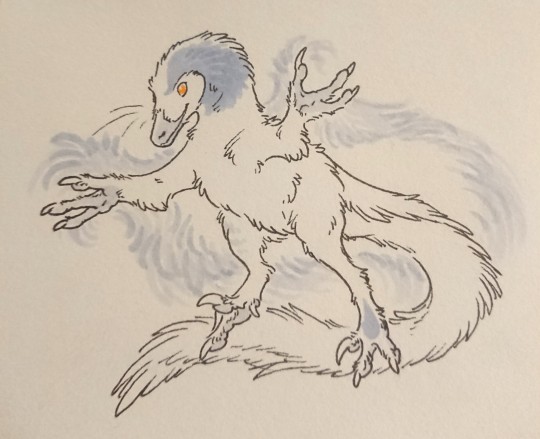
A character from the myths/folklore of the Singing People.
Wind Cloak is a popular character in many myths. They are usually a mysterious but wise figure, who often rewards good people with advice, or tricks evildoers or rude people into trapping themselves.
Often portrayed as a gynandromorph, Wind Cloak can be any gender, or appear as different animals, using a cloak made of wind and clouds to change shape as they see fit.
Storytellers and dancers often wear cloaks adorned with white feathers and quills when portraying them.
(While naming yourself directly with folklore characters' names is seen as a bit of a taboo, things like "White Cloak" and other names containing the word Cloak are somewhat popular names among genderqueer and intersex Singing People.)
104 notes
·
View notes
Photo
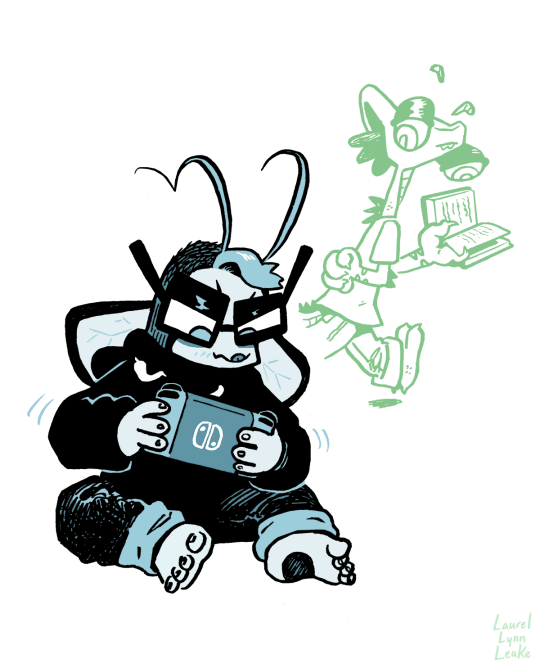

Recent birthday gifts for @gynandromorph! First drawing is of their fursonas gray (cockroach) and Dupe (chameleon), and second is of the protagonist Kim (spotted linsang) from their excellent webcomic Fresh Meat, which is coming to a close soon. That means it’s the perfect time to jump in as a new reader or give the whole comic a reread! ;P gray’s comics are so thoughtfully written and beautifully executed, and every time I return to them, I notice something new that brings further depth to the story. There’s really no one making comics like they do, and I’m super thankful they’ve made so many and share them online for free. So to celebrate their bday, do yourself a favor and read their comics (after checking the content warnings first of course)!
22 notes
·
View notes
Text
Half Male-Half Female Songbird Captured In Pennsylvania
https://sciencespies.com/news/half-male-half-female-songbird-captured-in-pennsylvania/
Half Male-Half Female Songbird Captured In Pennsylvania

An extremely rare bird with half its body looking like a male and the other half like a female was captured recently at a nature reserve in southwestern Pennsylvania

A gynandromorph rose-breasted grosbeak (Pheucticus ludovicianus) was recently captured and banded … [+] during autumn migration at Powdermill Nature Reserve in Pennsylvania. This particular individual has male markings on its right side and female markings on its left side. (Credit: Annie Lindsay, Powdermill Nature Reserve/Carnegie Museum of Natural History)
Annie Lindsay, Powdermill Nature Reserve / Carnegie Museum of Natural History
One of the most enjoyable aspects of birding is that I never know what I’ll find. Oh sure, I have a good idea what to expect, but I never know what I’ll see until I get out there and look.
Such was the situation for a team of bird banders working at Powdermill Avian Research Center (PARC) located in the Laurel Highlands of southwestern Pennsylvania, 55 miles southeast of Pittsburgh. This facility, which is part of the Carnegie Museum of Natural History’s biological research station at Powdermill Nature Reserve, comprises 10 hectares of fields, hedgerows, ponds, wetlands, and streams, providing many opportunities for research with wild birds. PARC scientists conduct bio-acoustic research, evaluate avian perceptions of glass in an experimental flight tunnel to learn how to reduce bird-window collisions, and they operate a bird banding station.
Recommended For You

Powdermill Avian Research Center (PARC) is part of the Carnegie Museum of Natural History’s … [+] biological research station at Powdermill Nature Reserve. (Credit: Joshua Franzos, Powdermill Nature Reserve / Carnegie Museum of Natural History)
Joshua Franzos, Powdermill Nature Reserve / Carnegie Museum of Natural History
It was late in the afternoon on 24 September so the bird banding team was almost finished for the day when something truly remarkable occurred: upon untangling a struggling bird from their nets, they found a songbird that looked as though it was composed of the lengthwise halves of two birds, one male and one female, that had been glued together into one individual. This bizarre bird was a rare gynandromorph, which is sometimes known more colloquially as a ‘halfsider’.

A banding team member carefully removes a migrating bird from a mistnet at Powdermill Nature … [+] Reserve. (Credit: Pamela Curtin, Powdermill Nature Reserve / Carnegie Museum of Natural History)
Pamela Curtin, Powdermill Nature Reserve / Carnegie Museum of Natural History
“We carry walkie talkies around the nets with us, and the field tech radioed back to excitedly say that they had a gynandromorph”, Annie Lindsay, Bird Banding Program Manager and a doctoral candidate at the University of Toledo, said in email. “[A]nd sure enough, when they brought it back, it was a half male, half female Rose-breasted Grosbeak!”
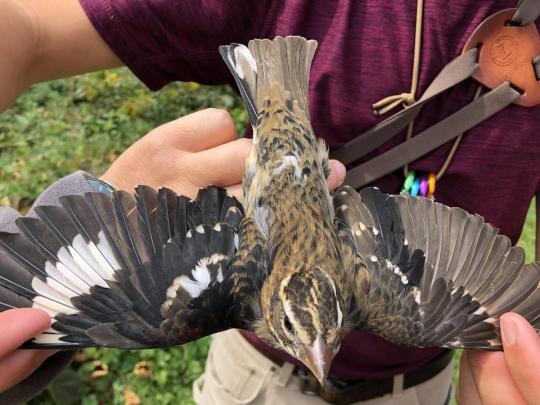
Gynandromorph rose-breasted grosbeak (Pheucticus ludovicianus) captured during autumn 2020 migration … [+] in Pennsylvania. This particular individual has male markings on its right side and female markings on its left side. (Credit: Annie Lindsay, Powdermill Nature Reserve/Carnegie Museum of Natural History)
Annie Lindsay, Powdermill Nature Reserve / Carnegie Museum of Natural History
“We were all excited and definitely surprised! Although we all have ‘wish lists’ of birds we hope we’ll see ‘in the hand’ someday, none of us really expected to catch a gynandromorph.”
These birds are incredibly rare: out of more than 750,000 birds captured during almost six decades of bird banding, the Powdermill Nature Reserve’s avian research center has recorded fewer than 10 bilateral gynandromorphs.
According to Ms Lindsay, this was a “once-in-a-lifetime experience.” Except, it would appear that Ms Lindsay has lived two lifetimes already because, astonishingly, this is the second gynandromorph that she’s seen — and captured — at PARC.
“I was at Powdermill in a different capacity when the other bilateral gynandromorph Rose-Breasted Grosbeak was caught in September 2005”, Ms Lindsay explained in email.
“I was working as a field tech then focusing primarily on bioacoustics work (analyzing nocturnal flight calls), so I saw the bird and recognized that it was quite the catch, but I understand better now how rare these birds truly are.”
Indeed. Even most active birders and nature photographers have never seen a live gynandromorph bird, and far fewer still have captured and banded even just one.
Like seeing a unicorn
“The banding team was starstruck by this bird”, Ms Lindsay said in email. “One of the crew said it was ‘like seeing a unicorn’; one described the adrenaline rush lasting the whole day; one talked about how they ‘never thought I’d see something so cool in my life’.”

The tail of a gynandromorph rose-breasted grosbeak (Pheucticus ludovicianus). Almost as if half of a … [+] male and half of a female bird had been sewn together into one living being. (Credit: Annie Lindsay, Powdermill Nature Reserve / Carnegie Museum of Natural History)
Annie Lindsay, Powdermill Nature Reserve / Carnegie Museum of Natural History
“The excitement and joy were palpable, and you could feel how special this bird was to them. Watching their expressions of happiness and awe made this capture even more extraordinary.”
Rose-breasted grosbeaks, Pheucticus ludovicianus, are common breeding birds as well as common visitors to backyard bird feeders in southwest Pennsylvania, where this bird was captured. However, most of the local rose-breasted grosbeaks had already departed for southern Mexico, Central America and northern South America for the winter, so this particular individual “was almost certainly a bird that spent the breeding season north of us and was migrating through our area”, Ms Lindsay explained in email.

Two male rose-breasted grosbeaks (Pheucticus ludovicianus) in breeding plumage visit a backyard … [+] birdfeeder. (Credit: Waldo Jaquith, CC BY-SA 2.0)
Waldo Jaquith via a Creative Commons license
“I aged the bird as an ‘after-hatching-year’ which means that it did not hatch this calendar year, so it’s at least one year old”, Ms Lindsay explained in email, then added: “We can’t age a songbird beyond knowing that it hatched this year or in a previous year, so this bird could be quite old, or it could be just one year old.”
Although this bird was in fresh autumnal plumage, which is considerably less fancy than its striking breeding plumage, it still shows distinct color differences. On its right side, it has rose-colored speckles on its brown-streaked breast, a rose-colored “wing pit” and black flight feathers — male plumage. On its left side, it has a yellow “wing pit” and brown streaks on its yellow breast plumage — female plumage.
“It was spectacular. This bird is in its nonbreeding [plumage], so in the spring when it’s in its breeding plumage, it’s going to be even more starkly male, female”, Ms Lindsay said.

Courting pair of rose-breasted grosbeaks (Pheucticus ludovicianus) in full breeding plumage. … [+] (Credit: with kind permission of the photographer, Chuck Hantis.)
Copyright by Chuck Hantis, all rights reserved
“Bilateral gynandromorphism, while very uncommon, is normal and provides an excellent example of a fascinating genetic process that few people ever encounter”, Ms Lindsay added.
A bilateral gynandromorph results from a developmental accident
In birds, sex is determined by sex chromosomes, just as in mammals. But unlike mammals, where females are XX and males are XY, female birds are ZW whilst males are ZZ (lots more details here). So the sex chromosome — either W or Z — determines the resulting chick’s sex.
To develop properly, the ovum sheds half of its chromosomes in a small package called a polar body before it is fertilized. But if both the egg’s nucleus and its polar body are fertilized by two different sperm cells (ref), and these nuclei start dividing separately, each side of the bird’s body develops its own sex because one side has female chromosomes (ZW) whilst the other side has male chromosomes (ZZ).
Because rose-breasted grosbeaks are sexually dichromatic, the differences between the sexes are readily apparent, especially when the bird attains breeding plumage. Thus, these gynandromorphs are readily visible, whereas gynandromorphs of other bird species where males and females look the same are almost impossible to spot.
This raises the question: is this bilateral gynandromorph grosbeak capable of breeding and raising chicks?
Can a bilateral gynandromorph breed?
Well, it’s complicated.
“Since usually only the left ovary is functional in birds, and the left side of this bird is the female side, this bird theoretically could produce young if it successfully mates with a male”, Ms Lindsay explained. “The bird’s ability to reproduce could also depend on whether it sings like a male, which would potentially attract females and elicit a territorial response from other males.”
But this is speculation at this point because there are no documented cases of bilateral gynandromorph birds successfully breeding in the wild nor in captivity.
Last year, I interviewed ecologist Brian Peer, a professor of biology at Western Illinois University, about a bilateral gynandromorph Northern cardinal that he studied (more here) and here’s what he told me then:
“I’m not sure that it is capable of breeding”, Professor Peer cautioned in email. “Because the female side is on the left doesn’t necessarily mean that the ovary is also on that side. The study by Zhao et al. (2010; ref) that we cited indicated that the [physical] appearance doesn’t always correspond with the gonad [location]. They found two birds that appeared male on the left half, but one individual had an ovary on that side. A third individual was female on the left side and had a combination testis-ovary structure.”
Such a combination structure, known as an ovotestis, is a gonad with both testicular and ovarian aspects and thus, is not fertile.
As Professor Peer explained to me last year, although we don’t know much about the breeding capabilities of gynandromorph birds, there is little evidence to suggest that they are fertile. Professor Peer did mention that gynandromorph songbirds can exhibit important courtship behaviors, like singing, that make it possible for them to form a pair bond, as documented in a study of a captive gynandromorph zebra finch that behaved as a male, yet also produced infertile eggs (ref).
Might this bird reappear next year?
“It’s unlikely that we’ll see this bird next spring, but not impossible”, Ms Lindsay said in email. “Most of the birds we recapture year after year are local breeders or winter residents, but less so with birds that are migrating through Powdermill.”
After photographing and banding the bird, Ms Lindsay took it to the lab where she measured its wing length and plucked two feathers from each side of the bird (four total) for genetic analysis, before releasing it to continue on its migratory journey.

Annie Lindsay examines a migratory songbird in the lab before releasing it. (Credit: Powdermill … [+] Nature Reserve / Carnegie Museum of Natural History)
Powdermill Nature Reserve
Has anyone reported seeing this special bird?
“No local birders reported seeing the bird, either before or after it was caught and banded”, Ms Lindsay replied in email.
It appears that this extraordinary songbird simply vanished, like a mythical unicorn.
#News
2 notes
·
View notes
Text
More Hork-Bajir thoughts and headcanons
Hork-Bajir have sexes (~4) but no genders.
-Gynandromorph A (1 horn- infertile- about as common as seers), female (2 horns- fertile produces eggs), male (3 horns- fertile produces sperm), and gynandromorph B (4 horns- low fertility produces both eggs and sperm- slightly more common than A type gynandromorphs)
- all sexes are raised and socialized the same. Sex has no influence on political or social power
--> Hork-Bajir are confused and alarmed by the whole ‘gender’ thing that humans and andalites have going on
-Have a ZW- like sex-determination system where the egg-producing sexes determine the sex of the offspring
-Are induced ovulators and ovoviviparous
-Are designed to have one baby at a time and tend to wait until the child is an adult to have another. Are capable of surviving up to triplets but it won’t be fun.
-All sexes produce crop milk for young babies
Names
-Parents discuss and decide on both given name and family name before the birth and present this name to the tribe in a birth/greeting ceremony for the child. Siblings close in age are less likely to have the same family name than siblings farther apart in age.
-->Horks in a political marriage between tribes will give their children family names made from mashing their family names together.
-Horks that lack a family name tend to be those who were orphaned and born in secret/away from their tribemates who would have given them some family name.
Marriage
-Horks tend to pair off about as soon as they enter adulthood and tend to remain with their partner for life
-Hork marriages are not sexually exclusive. Borrowing someone else’s partner to sire/dam offspring is relatively common.
--> Hork’s born from such borrowing have hyphenated family names to help folks keep track of their lineage
-Horks very rarely divorce. The few things horks divorce over include bad parenting skills and dropping the baby. They lived in mile-high trees, dropping the baby is very serious. Serial baby dropping is grounds for banishment.
13 notes
·
View notes
Text
It will be available from the first of May 2019. The apartment is rented with a parking space on the condominium grounds. Central heating. These days, beauty parlors are occupied by ladies who are very much interested in face massage, clean up, manicure, pedicure, waxing and shampooing of hair followed by a hair massage. Various health and beauty companies and beauty products suppliers are supplying various beauty products for women as per the latest trends. These pioneer companies are perfect choice for those people who wish to buy herbal and beauty products in bulk amount at reasonable price.. Earlier this year, a sighting of a rare cardinal thrilled countless birdwatchers when it appeared in a Pennsylvania backyard. The bird, whose plumage was split practically down the middle one side a cherry red, the other a soft mix of yellow and brown is a type of animal known as a gynandromorph. Although they sound like something straight out of a sci fi novel, gynandromorphs are very real if not entirely common. I mean I didnt need a review to tell me the game was shallow, and every single quest and campaign had the EXACT same unfolding events, as if they designed them all on a template and then copy pasted unique dialogue and locations. It actually embarrassing, fetch this, kill this, talk to this. Literally every single thing. The flaming opposition in their front grew with their advance until it seemed that all for ward ways were barred by the thin leaping tongues, and off to the right an ominous demon stration 함평출장안마 could sometimes be dimly discerned. The smoke lately generated was in confusing clouds that made it difficult for the regiment to proceed with intelligence. As he passed through each curling mass the youth wondered what would confront him on the farther side.. Think he was from Africa been In USA about 10 years. I said man can I ask you a question. I said sir I couldn do your job because I would be scared of being robbed or worse, shot. My mom wore a small amount of makeup before. Once I started really getting into it and learning a lot about products, she got more into it as a way to bond with me. I took her to sephora for the first time and she got a makeover and loved it. On the second floor there are two other bedrooms, a bathroom and a storage area. Within the property there is also an independent area for the service staff, consisting of a bedroom, a bathroom and the laundry area. The villa is characterized by large French windows that permit the access to the outdoor areas and permit to enjoy an incredible view of the lake, 함평출장안마 in addition to being surrounded by other gardens belonging to the houses of the surroundings that guarantee a lot of privacy.. I also have taken leather boots to the cobbler they can stretch the front part for you. I usually have good luck with Clark brand, but i also love my Dr. Martens with a bunch of heel grips. In most cases, patch veneer should not be taken from the same piece of furniture; you'll have to buy matching veneer to make the repair. If only a small piece is missing, you may be able to fill in the hole with veneer edging tape, sold at many home centers and lumberyards. Or, if you have access to junk furniture, you may be able to salvage a similar veneer from another piece of furniture.
1 note
·
View note
Text
gynandromorph replied to your post: no matter what, i can’t change my high school...
meredith PLEASE tell me this design was not so very “invader zim” by chance, was you teenage self a zim fan
...FUCK
yeah, to an obsessive degree, for around 2-3 years
it was basically what inspired me to join deviantart and start posting artwork online
tbh, the entire reason i made that ‘hey what does my art style remind you of’ post a while back was to gauge how much of that is still recognizable in my art style, because it absolutely was a few years back and i could NOT tell then
there’s some stuff about that style that i still like and don’t mind influencing my work (interesting color palettes, heavy use of strong shapes that you need to learn how to turn in space in order to draw correctly, impressive line weights and shading for a television cartoon from that era especially)
but then there’s other shit like ‘every main character had the same body type (skinny cylinder with cube on top)’ and ‘almost nobody in real life actually stands with their arms straight down at their sides and their hands uncomfortably angled upwards behind them’ that are less desirable art traits, to me, and BOY did they take me a long time to unlearn
#gynandromorph#invader zim kind of hurts me in that i remember how much i loved it and some of the nice things about it#but the writing just absolutely isn't my thing anymore; the jokes just aren't... funny... 90% of the time...#that being said when i saw the first season DVD for sale at goodwill i DID buy it#i remembered distinctly how everyone on those audio commentaries would just lie about shit and i couldn't tell what was jokes as a kid#so i honest to god thought that vasquez really did have nickelodeon cover their skylights with red seran wrap#only for it to turn all the light pink instead of red like was intended#OH- another good thing about invader zim was the theme song; it was legitimately very very good and i think that's what actually hooked me#because my friend who introduced me at the time was VERY hot topic goth and i was decidedly not#also i'm gonna have to watch the movie when that comes out#out of obligation to teenage me
5 notes
·
View notes